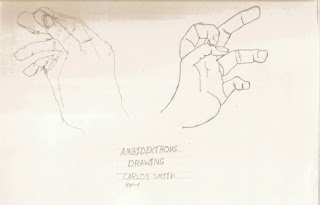





When I started my project my three ideas were based on making things out of the twigs. The chair and the cedar shake roof were both ideas made of twigs. From the critique I learned that these ideas were too literal of what they were- taking away from the twigs, and not establishing a place for the twigs.
My second idea was to focus on the small details of the twigs such as their tiny eye shaped natural engravings. I created a sanctuary sh

aped like an eye with the "eyes" of the twigs hanging down within the eye sanctuary. This idea did not work as it didn't hold together well and the colors I chose to paint the eye did not relate or help the project.
Inspired by a wooden puzzle box in my mother's living room, I decided to create a puzzle box like paper box. My mother's puzzle box had many boxes within and around the main box/shape. The box was made up of these little boxes. In simplifying I decided to create a triangular box having three identical corners, however one would slide out encasing the 12 twigs.
In my first iteration I created exactly that. Interactivity being one of my main goals, my problem was that there was no way of making the observer want to engage with the box as the twigs could not be seen and the observer would not know how to open the box. From talking with Stoehl I decided to make another iteration with a window going through the box showing the twigs. I also later decided to make it so one corner had a handle to show that that was the one that came out. I chose the orange and dark gray colors to complement the inside and outside colors of the twigs. The inside box/tray had the twigs weaved into it so that when looking through the hole there is negative space between the twigs as you see through to the other side. My goal of interactivity was met as the T.A. who examined my box looked through and pulled out the twig tray within.














































